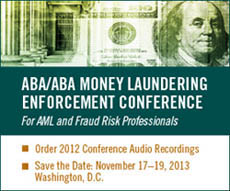Cresting problems for flood insurance
Uncomfortable decisions blow in with Sandy
- |
- Written by Lucy Griffin
- |
- Comments: DISQUS_COMMENTS

Were you watching? Did you see the pictures of New York City after Hurricane Sandy hit?
If you were watching, and you are a compliance specialist, you were surely thinking about flood insurance. Whenever a disaster involving serious flooding occurs, we can expect attention to turn to flood insurance. The problem now is predicting just what that attention will be and what we should do to be ready.
A perennial challenge, that comes home to roost
We know the standard problems. Mortgage customers don't like flood insurance and they think it is an unnecessary cost. Mortgage customers tend to be excited about the great price they got on the property--which is, of course, low precisely because the property is in a high-risk flood hazard zone. After this "success" they feel they can negotiate anything--like having to buy flood insurance. So when the loan officer sends the flood insurance notice, the customer is unimpressed and ready to argue.
Flood insurance has always been the black sheep in the flock.
No matter what the issue is, flood insurance takes heat. First, customers don't want to buy it. (Actually, they don't want to pay for it.) So they do whatever they can to avoid buying it.
They don't think refusing to buy flood insurance is risky because they believe that disaster funds will bail them out if a flood actually happens. But what are the chances of that?
Next, customers try to lower their costs by doing slick things, like lowering the amount of insurance or not renewing at all. That's why mortgage lenders have to do life-of-loan tracking to make sure that insurance remains in place.
Then there are arguments about pricing. People who get good deals by purchasing property located in a high-risk flood hazard zone object that the price of flood insurance is too high. Why, after all, should they have to pay more for insurance than people whose property is high and dry? Never mind that we know what the risk is--high.
And there are people who tend to see anything government does as some sort of plot--especially if something comes up on a slow news day. When FEMA announces that it is remapping areas, the government plot theorists start stories that the process is really a cover for generating more money for the flood insurance fund.
When FEMA undertook a significant remapping exercise following Mississippi River flooding, the news stories were all about the suspicions about a government conspiracy afoot to generate more income for the fund. Some people suspected that remapping really wasn't needed. It was simply a cover for making more people purchase flood insurance.
The post-Sandy environment
That was before Sandy. After these disasters, the news story is all about the lack of funds in the flood insurance fund. How could this happen?
Clearly, it is because flood insurance premiums are too low.
Too low?
Customers object to flood insurance because it is so expensive!
Raising rates could make things worse. But the current argument is that taxpayers are being asked to bail out the flood insurance fund--even taxpayers who carefully avoided purchasing property located in a high risk flood hazard zone. Not fair!
But something has to be done. The flood insurance fund is empty. What is possible?
One solution is obvious: Raise flood insurance rates. That may sound reasonable but our loan officers won't be happy about it. It is hard enough now to deal with customers required to purchase flood insurance.
Raising the rates will simply make things more difficult. Not a great idea.
Other ideas are even less attractive. One approach would be to make all mortgage customers purchase flood insurance. Hazard insurance is not enough. Even though the improvement is safely high and dry, flood insurance could be required. This could provide significant support to the flood insurance fund but it certainly wouldn't make customers happy. It would be a particular problem if the customers whose properties are located in high-risk flood hazard zones claim that they shouldn't have to pay more than the high-and-dry property owners.
Long-term implications aren't pretty
So fundamentally, this could come down to whether and how we can build improvements in high-risk flood hazard zones.
In the U.S., property ownership is almost sacred. We let people do what they want with their property, within reason. Zoning is the primary control for how property is used. The idea of telling people that they can't build on riverside or beachfront property is un-American. So is the idea of telling people that they can't rebuild. So rebuild they will--and continue to drain the flood insurance fund while the public policy question hangs out there.
Now for the final problem: What is not a high-risk flood hazard zone today could be tomorrow.
As the ocean rises, more properties become high risk.
So, should we perhaps require all owners of improved real property to maintain flood insurance?
If the U.S. mandated that everyone buy flood insurance, compliance would be much easier. But customers probably wouldn't like it.
On the other hand, nothing requires a bank to accept property located in a high-risk flood hazard zone as security for a loan.
The lender may deny the application because the property is located in a high-risk flood hazard zone. Nothing requires the lender to accept this risk. It would have to be explained on the adverse action notice, but the decision and the policy behind it would be defensible.
Or, things could stay as they are.
Which option do you want?
Disclaimer: Lucy Griffin's views are her own, and not necessarily those of the American Bankers Association.
Tagged under Compliance, Blogs, Common Sense Compliance, Compliance Management,














